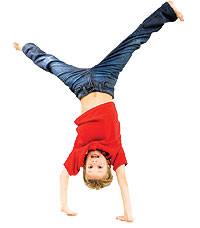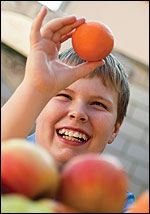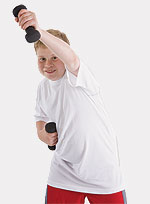New and creative meets tried and true as video game technology, cell phone texting, and bariatric surgery team up with better nutrition and traditional exercise to help kids and teens who are obese to move, lose, and get healthy.
Sometimes it seems as if today’s kids are born with computer chips in their brains and cell phones clutched in their tiny fists. Rather than fight this evolutionary trend, innovative video game developers, educators, and healthcare professionals are tapping into kids’ and teens’ technology passions to supplement conventional diet and exercise strategies to combat the surge in childhood obesity.

Over the past three decades, childhood obesity rates have tripled, and almost one in three children in the United States is overweight or obese, according to the Let’s Move! initiative launched last year by First Lady Michelle Obama. Obesity unleashes a plethora of psychosocial and medical risks for children and teens that can continue into adulthood. Besides these health risks, overweight and obese young people with limb loss or musculoskeletal/ neurodevelopmental conditions requiring orthotic intervention may not be able to enjoy optimal outcomes in their prosthetic and orthotic care and the increased mobility, function, and quality of life such interventions can provide.
Getting Active with Exergames
Interactive fitness, known as active gaming or “exergaming,” is a popular trend that offers sports such as hip-hop dance and tennis, which is played with a remote-control-style racquet. The University of South Florida (USF), Tampa, has been at the forefront of active gaming research and opened the first active gaming laboratory in 2007.
Lisa Hansen, PhD, assistant professor in USF’s School of Physical Education and Rehabilitation Science and co-director of the university’s Active Gaming Research Laboratories, is a passionate advocate of interactive fitness. “Active gaming is fun,” she says. “Kids want to do it!”
Hansen also is the director at Game Doctor (www.gamedoctor.org) and managing editor of the active gaming content on PECentral.org (www.pecentral.org); both of these websites offer helpful information on active gaming.
Research conducted at USF’s Active Gaming Research Laboratory, located at the nearby Belle Witter Elementary School, showed that students were enthusiastic about and engaged in the video gaming programs; another recent study at the USF Patel Partnership School involved placing active games in a classroom setting. Results underscored how young students performed better academically and exhibited better classroom behavior after gaming, Hansen says.
Shellie Pfohl, MS, executive director of the President’s Council on Fitness, Sports & Nutrition, watched a demonstration at the Active Gaming Research Laboratory last November. Impressed, Pfohl says, “The phenomenal work USF is doing in active gaming-to show that physical activity, learning, and fun can work together-is model research.”
M. Jason Highsmith, DPT, CP, FAAOP, assistant professor in the USF School of Physical Therapy and Rehabilitation Science, suggests that youngsters who are shy or uncertain about their physical abilities and therefore draw back from sports and outdoor activities, can benefit from and enjoy active video gaming at home with family and friends.

Although the USF research is more focused on using active gaming in school physical education programs, Hansen notes that it is gaining in popularity for home and clinic use. “It will continue to grow,” she says. “It is not a fad that’s going to go away.” However, she stresses that active gaming is a complement to conventional physical education, sports, and recreation activities, not a replacement.
The American Physical Therapy Association (APTA) publication PE in Motion, discusses positive results of active gaming technology in clinical settings in the article, “Video ‘Games’ in the Clinic: PTs Report Early Results,” by Claire Coyne (March 2008). For instance, Massachusetts General Hospital (MGH) Children’s Service, Boston, has seen good results in pediatric patients using the Dance Dance Revolution (DDR) system. “We have incorporated DDR into therapy sessions for some time now, specifically to address the aerobic conditioning and airway clearance components of the plan of care for our patients with cystic fibrosis,” Jessica Jacavage, PT, is quoted as saying in the article.
“In one important way, the addition of a virtual component to treatment has had an unanticipated result,” the article continues. “We have seen an increase in our patients’ self-esteem,” Denise Montalto, PT, NCS, says. “The children celebrate each step up and are eager for their next exercise session. They also share this activity with their friends and family.”
Texting: Motivating Kids to Make Better Choices
The University of Michigan C.S. Mott Children’s Hospital Pediatric Comprehensive Weight Management Center, Ann Arbor, multidisciplinary team of physicians, a dietician, psychologist, social worker, exercise physiologist, and physician’s assistant help obese children and teens through its MPOWER (Michigan Pediatric Outpatient Weight Evaluation & Reduction) program (www.med.umich.edu/mpower/index.shtml).”It’s very hard for child and teen patients to maintain motivation between visits,” says Susan J. Woolford, MD, MPH, center medical director and clinical assistant professor with the Child Health Evaluation and Research (CHEAR) unit in the university’s Division of General Pediatrics. “So we asked, ‘How can we help them think about the reasons why they want to make healthy choices and why they want to achieve a healthy weight?'”
Then, an “aha!” moment occurred. “We realized that practically every adolescent that comes into our office has a cell phone and texts regularly. So we thought that might be a reasonable way to interact with them between visits.”
Woolford and other University of Michigan specialists undertook a three-month pilot study, using a program developed by the university’s Center for Health Communications Research. Each of the 20 participants received one message per day, outside of school hours. Messages were somewhat tailored to each teen based on a questionnaire the participants completed before beginning the study, which included some of their eating and exercise preferences. For instance, if a teen indicated a preference for dairy products, a message about a healthful breakfast would include dairy recommendations.
The results were promising. “The teens were very enthusiastic about the messages and enjoyed getting them,” Woolford says. “They indicated that the messages helped them make healthy choices and keep being healthy at the forefront of their minds.”
(Author’s note: For more information, see the Journal of Telemedicine and Telecare, December 2010; jtt.rsmjournals.com/cgi/content/abstract/16/8/458)
“We will begin a randomized trial in a couple of months to see if the results go beyond enjoying the messages,” Woolford continues. “We want to know if they help kids stay engaged in the weight-management program and if they help them achieve a healthy weight.”
Bariatric Surgery
When non-surgical approaches fail, the University of Michigan Children’s Hospital is among hospitals offering bariatric surgery as an option for adolescents. “Weight loss surgery is not an easy solution for obesity and alone does not cure obesity,” the Pediatric Comprehensive Weight Management Center website warns. The surgery carries the usual message regarding pain and risks associated with major surgical operations and requires family support and a lifelong commitment from the adolescent to maintain new diet and exercise habits, the site notes. Long-term comprehensive follow-up care is tailored to the needs of individual patients and includes medical evaluations, as well as psychological and nutritional counseling for patients and families.
Candidate requirements are stringent and include a body mass index (BMI) of 40 or greater with two severe obesity-related illnesses or a BMI of 50 or greater with two less-severe obesity-related illnesses; a Tanner (growth) stage of at least IV; and active participation for a minimum of six consecutive months in a multidisciplinary pediatric weight-management program. Candidates also must receive approval from the center’s multidisciplinary review committee.
Woolford says that she feels the surgery has had positive results for their adolescent patients.
Overall, bariatric surgery for adolescents is gaining in acceptance among physicians, surgeons, and patients although it is still controversial. However, some research findings indicate that teen weight-loss surgery patients experience similar weight loss and health improvements with fewer complications when compared to adult patients (www.bariatric-surgery-source.com/adolescent-bariatric-surgery.html). Research has also found that the sooner an obese patient loses weight, the lower his or her achievable weight will be, the site notes.
Obesity and Pediatric O&P
Obese pediatric patients with limb loss face much of the same challenges as do obese adult patients, according to Highsmith and Donald R. Cummings, CP, LP, Orthotics and Prosthetics Department, Texas Scottish Rite Hospital, Dallas.
“One of the biggest problems is dealing with volume changes in the residual limb throughout the day, and as children grow, their residual limb circumference and body weight increase,” Cummings says. “When you add obesity to these normal challenges, it really exacerbates them.”
More patients are requiring components rated for heavier weight levels, even up to 500 pounds, Cummings says, which limits the variety of components available to them. It is especially difficult to match weight ratings to activity levels for obese children, who may be highly active. More durable components often are rated for lower weights, thus these active but obese youngsters can experience considerable component breakage. Balancing patient safety, activity levels, and component weight ratings can be a real challenge, Cummings says. “Most pediatric components are rated up to 100 pounds, but when you have a child heavier than that, although still in pediatric sizes, you may have to try to use and adapt adult-size components so they aren’t as likely to break.”
Adolescent patients who are obese have fewer problems with balancing components with activity and weight levels since they are generally able to use adult-size componentry.
However, maintaining good socket fit is still the major challenge, Cummings explains, and more fatty tissue in the limb causes larger changes throughout the day, and muscles can’t provide a firm foundation for controlling the socket. Obese patients also are more prone to skin breakdown due to increased pressure from the prosthesis.
Highsmith recommends talking frankly but tactfully with parents and patients about addressing weight issues. He provides a perspective on sports and exercise choices since several aspects should be considered. Parents, for example, need to factor in whether there are equipment costs and entry fees for the sporting activities they are considering. Some questions to ask are: “Does the child want to do this activity? What is the cost and time involved?” For children who have poor body image or are not self-confident about their abilities, putting them in a high-visibility sport may not be a good choice. “For instance, in baseball, the spotlight may be on that individual child at bat, and whether he succeeds or fails, it’s in front of everyone.” Lower-visibility sports, such as soccer, where there are a number of players participating at the same time, may be a better option, he notes.
Competitive sports and unstructured play-“simply letting a kid be a kid”-are beneficial, Highsmith believes. “An important aspect I don’t think is getting the attention it deserves is the difference between sports and lifetime fitness pursuits,” he continues. Lifetime fitness activities such as weight lifting may not be appropriate for young children whose skeletal growth plates are still developing, he says. “This could cause musculoskeletal problems, and the child likely wouldn’t even enjoy it.”
The healthcare team has to be aware of the exercise plan guidelines, considering such questions as how much exercise is appropriate and what are the most appropriate activities, Highsmith points out, adding that the team needs to be able to recognize signs of underactivity or overactivity in the child’s progress.
Exercise, healthful eating, appropriate healthcare interventions, the patient and his or her family, all play vital roles in overcoming pediatric obesity. The stakes are high-and the prize can be a lifetime of health, fitness, and joy in living.
Miki Fairley is a freelance writer based in southwest Colorado. She can be reached at
Fight Obesity with Healthful Eating
Unhealthful eating patterns coupled with limited physical activity are the leading causes of childhood obesity, according to the Centers for Disease Control and Prevention (CDC) and the Let’s Move! initiative (www.letsmove.gov).

More consumption of calorie-dense, fat- and sugar-laden convenience foods, a huge increase in sugary soft drink consumption with a corresponding plunge in consumption of healthier beverages such as milk and fruit juice, and exploding portion sizes have led to Americans ingesting 31 percent more calories than they did 40 years ago. And it’s not only calories-today’s Americans are consuming 56 percent more fats and oils and 14 percent more sugars and sweeteners than in the 1970s. Only 21 percent of young people eat the recommended five or more servings of fruits and vegetables each day, and nearly half of all vegetable servings eaten are fried potatoes.
While there’s no doubt that fast food is here to stay, it is possible to still make healthful, relatively low-calorie, high-nutrient choices in fast food. There are numerous websites that provide information about healthful fast food options. Here are a few of our favorites:
- www.webmd.com/food-recipes/healthtool-fast-food-choices
- www.helpguide.org/life/fast_food_nutrition.htm
- www.healthchecksystems.com/ffood.htm
- www.sparkpeople.com/resource/nutrition_articles.asp?id=1193
- www.health.com/health/article/0,,20411588,00.html
Good Choice Guidelines
KidsHealth (www.kidshealth.org), part of The Nemours Foundation’s Center for Children’s Health Media, aims to provide families with perspective and advice about a wide range of physical, emotional, and behavioral issues that affect children and teens. Site visitors can click on sections for parents, kids, and teens, respectively, which offer a variety of information about healthful eating and weight management.
The teen site’s healthy weight section offers an interactive planner for weight loss. The planner helps to make reaching goals easier by breaking them into more manageable steps.
A few websites with sections on healthful eating include the following:
- WebMD: http://children.webmd.com/guide/kids-healthy-eating-habits
- Centers for Disease Control and Prevention (CDC): www.cdc.gov/healthyweight/children/
- The National Institute of Diabetes and Digestive and Kidney Diseases (NIDDK) Weight-Control Information Network (WIN): win.niddk.nih.gov/publications/child.htm
- U.S. Department of Agriculture: www.nutrition.gov/nal_display/index.php?info_center=11&tax_level=1
Besides these, there is a cornucopia of websites featuring delicious, healthful recipes. Bon appétit!
Best Exergames

The Exergame Network (TEN), an international collaboration of dedicated health and fitness practitioners, exergame developers, researchers and clinicians, health and fitness entrepreneurs, and passionate individuals devoted to highlighting the best solutions offered by exergaming, held its inaugural TEN Awards last year. Winners were selected in 15 categories.
The following are likely to be of interest to obese/overweight prosthetic and orthotic pediatric patients, families, and healthcare professionals:
- Best Children’s Exergame: Konami Dance Dance Revolution Disney Grooves.
- Best Home Exergame 2010: Microsoft Kinect™ Sports.
- Best Accessibility Exergame: Nintendo® Wii™ Sports.
- Best Rehabilitation Exergame: Nintendo Wii Fit and Wii Fit Plus.
- Best Home Dance Exergame: Konami Dance Dance Revolution.
- Best Competition Exergame: Gamercize® Pro-Sport™ for Xbox 360.
- Best Group Exergame: Positive Gaming iDANCE2.
For more information, or to view the full list of 2010 TEN Awards winners, visit www.exergamenetwork.org




